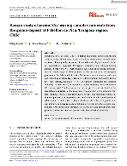Raman study of several Cu-bearing complex minerals from the guano deposit at Pabellón de Pica, Tarapaca region, Chile

Datum vydání
2023Publikováno v
Journal of Raman SpectroscopyRočník / Číslo vydání
54 (11)ISBN / ISSN
ISSN: 0377-0486Informace o financování
UK/UNCE/SCI/UNCE/SCI/006
UK/COOP/COOP
Metadata
Zobrazit celý záznamKolekce
Tato publikace má vydavatelskou verzi s DOI 10.1002/jrs.6506
Abstrakt
Pabellón de Pica, Tarapaca, Chile, is a former guano mine exploited in the late 19th and early 20th centuries. Guano is in a direct contact with Cu sulfide mineralization leading to the formation of minerals with a highly unusual chemical composition, especially Cu-organic complexes and nitrogen-bearing phases. In this work, we report results of the Raman spectroscopic investigation of several unique Cu-bearing minerals that are the result of supergene processes at the Pabellon da Pica site. We focus on several minerals with new and interesting structure types which were described from this locality for the first time, namely, antipinite (K-Na-Cu oxalate), ammineite (Cu ammine complex), chanabayaite (Cu ammine triazolate complex), and joanneumite (Cu isocyanurate). The Raman spectra contain specific bands attributed to the characteristic vibrations of the molecular groups present in the minerals (oxalate, ammine, triazolate, and isocyanurate groups) and vibrations within Cu-centered polyhedra. A comparison was made with the vibrational spectra of related minerals and synthetic phases, which revealed substantial proliferation and shifting of numerous bands, which is in agreement with the complex composition of the investigated minerals. The results obtained appropriately complement known structural and spectroscopic data published previously.
Klíčová slova
ammine, Cu complexes, organic minerals, oxalates, Raman spectroscopy
Trvalý odkaz
https://hdl.handle.net/20.500.14178/2398Licence
Licence pro užití plného textu výsledku: Creative Commons Uveďte původ 4.0 International






